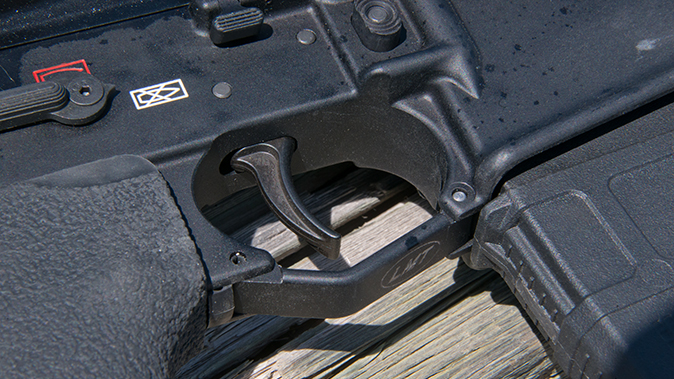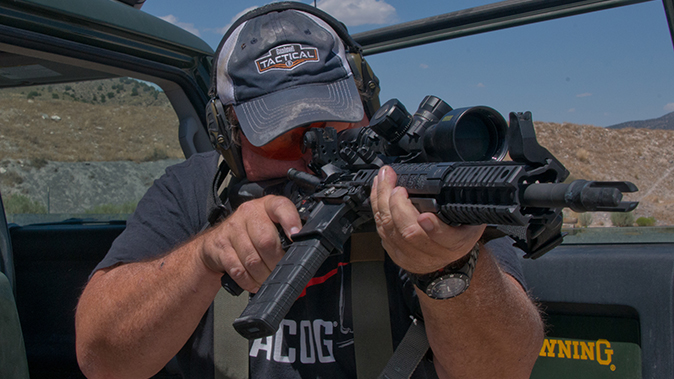Lewis Machine & Tool (LMT) is known for building some of the toughest AR-platform rifles available. For years, LMT rifles have been the choice of military professionals, police officers and anyone looking for exceptionally strong weapons. Building rifles and components for warfighters has given the company an operational perspective, so everything it makes is simple, proven and reliable.
LMT has also designed a number of improvements for the AR platform, including an enhanced bolt carrier group as well as the MRP, or Monolithic Rail Platform. The MRP was the first upper receiver built from a single billet of aluminum with an integral handguard for added durability. Special operations warriors tend to trick out their rifles with lots of accessories, including optics, lights and lasers, to rule the battlefield. Adding all of that weight can cause a standard upper or handguard to crack or fail over time. But the added strength of the one-piece MRP design prevents this.
And, on top of everything else, the MRP allows operators to quickly swap barrel assemblies in the field. The system secures the barrels in such a way to minimize point-of-impact shifts while allowing them to float freely for enhanced accuracy. In short, the MRP upper is truly innovative, and it’ll fit on any AR-style lower receiver—including LMT’s new, fully ambidextrous MARS-L.
Advertisement — Continue Reading Below
For All Shooters
As its name implies, the MARS-L (Modular Ambidextrous Rifle System-Light) lower receiver features ambidextrous controls that mirror each other on both sides. Each control is positioned to be as similar as possible to its companion on the other side. This makes it possible for users to manipulate the controls and operate the rifle from either side without needing a different manual of arms for each side. This is something many military and police agencies have been requesting for years.
Advertisement — Continue Reading Below
While ambidextrous lowers are starting to become common on various sporting and competition rifles, LMT’s MARS-L is one of the most intuitive I’ve used to date. On the left side you’ll find a standard bolt stop and safety as well as a new magazine release that’s placed a little lower than the right side’s. A small guard protects it from inadvertent activation. The right side hosts a bolt catch/release. While other designs only release the bolt, this version allows you to lock the bolt to the rear by pressing the button, eliminating the need to remove your control hand from the rifle. The safety levers are mirrored with clear pictograph markings on both sides.
LMT’s collapsible SOPMOD stock is installed on the mil-spec buffer tube. More features include the rubber pistol grip and extended triggerguard. Rounding out the lower is LMT’s excellent two-stage trigger.
The MARS-L rifle I was sent for testing came equipped with an MRP upper receiver featuring a quad-rail system that houses a 16-inch, chrome-lined barrel with a 1-in-7-inch twist rate. The barrel has a 5.56mm NATO chamber and an A2-style flash suppressor. LMT’s enhanced bolt carrier group is installed along with an ambidextrous charging handle. Finally, the rifle came with a set of removable A2-style sights and an aluminum 30-round magazine.
Advertisement — Continue Reading Below
I tested the MARS-L in two configurations. For the first setup, I kept the iron sights in place and added a Trijicon MRO sight to the flattop upper. This is a common setup for a self-defense or patrol rifle. I also replaced the A2-style flash suppressor with a SureFire WarComp 556 and added a Blue Force Gear Vickers two-point sling. I used mil-spec aluminum Brownells magazines and several Teflon-coated BCM magazines with CTT Solutions basepads.
Previous MRP testing yielded excellent accuracy results, prompting the second configuration. I replaced the LMT sights with a set of offset Dueck Defense RTS sights. I also added a Bushnell 3.5-21x50mm HDMR scope using a Horus TReMoR 2 reticle in an Alamo Four Star mount. Extensive experience with this system has yielded excellent results to the limits of the 5.56mm NATO cartridge. I used SureFire’s SOCOM556-RC2 suppressor for much of the long-range testing. For prone shooting, I used an Atlas bipod and Magpul’s 20-round PMAGs.
Rounds Downrange
Advertisement — Continue Reading Below
This is the third MRP-based rifle I’ve tested over the years, and they’ve all been accurate. My best 100-yard group came with Black Hills’ 69-grain TMK ammo at 0.75 inches. This load was also the best performer out to 500 yards. Firing from prone with no support, Remington’s 77-grain Premier Match created a 0.6-inch group at 50 yards, which is closer to a real-life engagement distance. Barnes’ 85-grain OTMs also performed well, only slightly less accurate than the best 77-grain ammunition.
Using Black Hill’s 69- and 77-grain TMK rounds, I could consistently hit steel at 200, 300, 500 and 650 yards. During the testing, 20-mph wind gusts made it a little harder to hit targets at 800 yards and beyond. During one 10-round string using the 77-grain TMKs, I was able to get four hits out of 10 on a 12-by-16-inch target—not bad for a 16-inch-barreled carbine on a windy day.
As mentioned, I’ve tested several rifles with ambidextrous controls in the last few months. While many, including myself, considered that an “extra” at one time, I’m starting to think it should be standard for most rifles. The more ambidextrous, the better—and the MARS-L is one of the best designs I’ve seen to date. Mirroring the controls so well makes it very easy to operate the rifle. It didn’t take me long to reload from the left side, and I’m right-handed. But the rifle really shined when I ran right-side reloads from the shoulder while on the move.
Advertisement — Continue Reading Below
When I stacked up with my SWAT teammates, I did not move the rifle into my “workspace” when reloading—I kept the rifle in the pocket with the muzzle downrange. I may rotate the gun slightly, but with practice, the rifle is back in the fight faster than most people can even start a transition. Using my trigger finger to release the magazine and then the bolt was extremely fast. Your control hand can stay in place during the entire operation. As a bonus, administrative unloading is simple and well controlled. In short, this design is very slick and well thought out.
Parting Shots
The “Light” part of the MARS-L name refers to its chambering, not its weight. While the lower weighs about the same as any forged unit, the MRP upper is a bit heavier. The rifle’s not overly heavy at 7.1 pounds, but it’s not particularly light, either. My test rifle’s quad-rail handguard undoubtedly added a bit of extra weight. But you can also order the CQB upper for shorter barrels or a streamlined SLK version to shed weight. If you need a ton of accessories, this version is incredibly strong.
Advertisement — Continue Reading Below
This rifle ran flawlessly with and without the SOCOM556-RC2 suppressor. With the suppressor in place, the ejection pattern didn’t alter much, and excess gas was kept to a minimum. This setup worked well for prone shooting with lower and slower round counts. Working the square range with fast split times and higher round counts, the WarComp would be my preference. The suppressor caused the point of impact to shift vertically 2.5 inches with the 69-grain TMKs—there was no side-to-side movement.
The real difference in this rifle is the lower receiver, and LMT has done a fantastic job here. In fact, the MARS-L came about because of a request from the New Zealand Defence Force, which is now fielding these rifles after thorough testing under real-world conditions. The controls are intuitive, easy to access and robust. The MARS-L is a great rifle, but if you don’t want the monolithic upper or barrel interchangeability, the lower is available on its own and will work with most any traditional AR upper. Select-fire versions are also available for government agencies. In the end, no matter the application, it’d be hard to go wrong with the LMT MARS-L.
Advertisement — Continue Reading Below
LMT Defense MARS-L Specs
| Caliber: 5.56mm NATO |
| Barrel: 16 inches |
| OA Length: 36 inches |
| Weight: 7.1 pounds (empty) |
| Stock: Collapsible |
| Sights: Adjustable front and rear |
| Action: Direct impingement semi-auto |
| Finish: Matte black |
| Capacity: 30+1 |
| MSRP: $2,500 |
LMT MARS-L Performance
| Load | Velocity | Accuracy |
|---|---|---|
| Barnes 85 OTM | 2,470 | 0.85 |
| Black Hills 69 TMK | 2,800 | 0.75 |
| Black Hills 77 TMK | 2,655 | 0.95 |
| Remington 77 Premier Match SMK | 2,650 | 1.10 |
*Bullet weight measured in grains, velocity in fps by chronograph and accuracy in inches for best five-shot groups at 100 yards.
For more information, visit lmtdefense.com.
Advertisement — Continue Reading Below

































